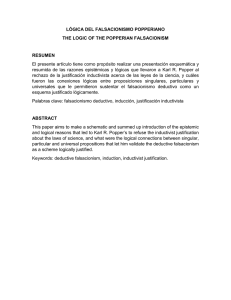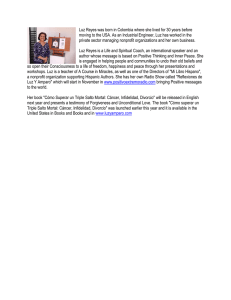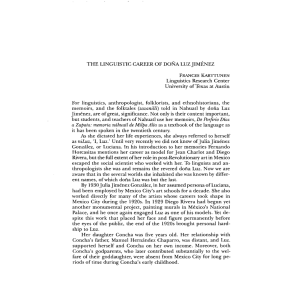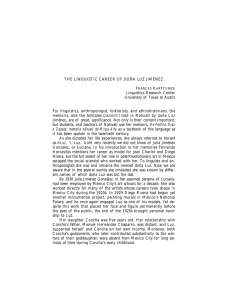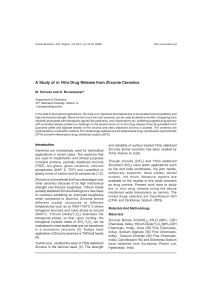Explorando propiedades: Pulseras ultravioleta
Anuncio
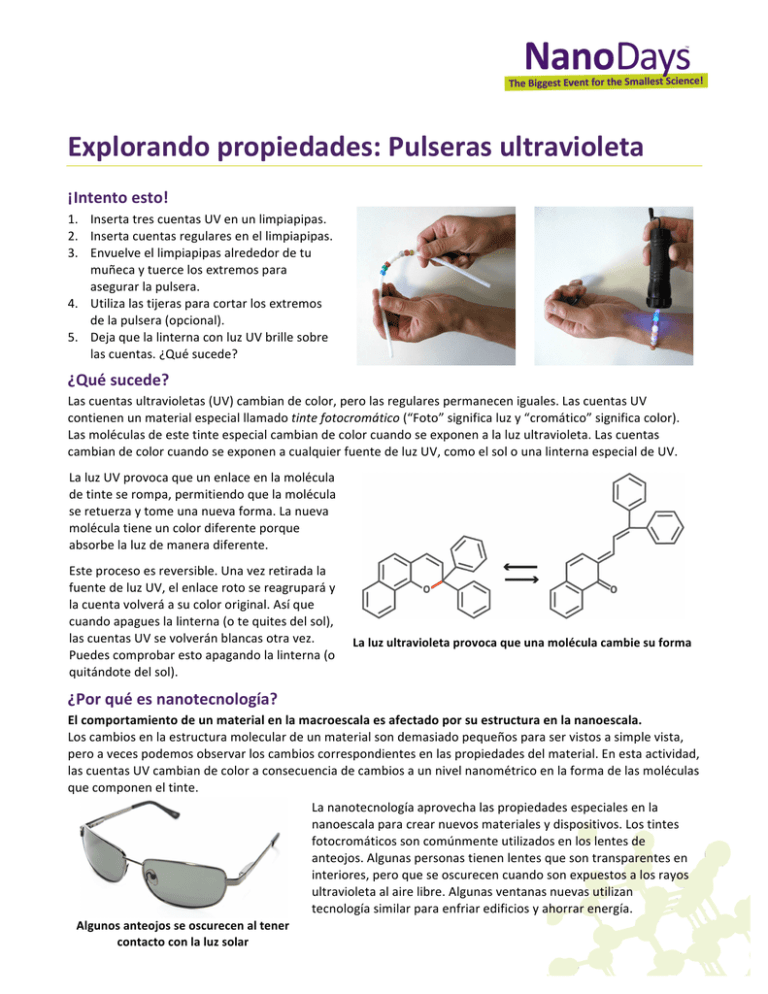
Explorando propiedades: Pulseras ultravioleta ¡Intento esto! 1. Inserta tres cuentas UV en un limpiapipas. 2. Inserta cuentas regulares en el limpiapipas. 3. Envuelve el limpiapipas alrededor de tu muñeca y tuerce los extremos para asegurar la pulsera. 4. Utiliza las tijeras para cortar los extremos de la pulsera (opcional). 5. Deja que la linterna con luz UV brille sobre las cuentas. ¿Qué sucede? ¿Qué sucede? Las cuentas ultravioletas (UV) cambian de color, pero las regulares permanecen iguales. Las cuentas UV contienen un material especial llamado tinte fotocromático (“Foto” significa luz y “cromático” significa color). Las moléculas de este tinte especial cambian de color cuando se exponen a la luz ultravioleta. Las cuentas cambian de color cuando se exponen a cualquier fuente de luz UV, como el sol o una linterna especial de UV. La luz UV provoca que un enlace en la molécula de tinte se rompa, permitiendo que la molécula se retuerza y tome una nueva forma. La nueva molécula tiene un color diferente porque absorbe la luz de manera diferente. Este proceso es reversible. Una vez retirada la fuente de luz UV, el enlace roto se reagrupará y la cuenta volverá a su color original. Así que cuando apagues la linterna (o te quites del sol), las cuentas UV se volverán blancas otra vez. Puedes comprobar esto apagando la linterna (o quitándote del sol). La luz ultravioleta provoca que una molécula cambie su forma ¿Por qué es nanotecnología? El comportamiento de un material en la macroescala es afectado por su estructura en la nanoescala. Los cambios en la estructura molecular de un material son demasiado pequeños para ser vistos a simple vista, pero a veces podemos observar los cambios correspondientes en las propiedades del material. En esta actividad, las cuentas UV cambian de color a consecuencia de cambios a un nivel nanométrico en la forma de las moléculas que componen el tinte. La nanotecnología aprovecha las propiedades especiales en la nanoescala para crear nuevos materiales y dispositivos. Los tintes fotocromáticos son comúnmente utilizados en los lentes de anteojos. Algunas personas tienen lentes que son transparentes en interiores, pero que se oscurecen cuando son expuestos a los rayos ultravioleta al aire libre. Algunas ventanas nuevas utilizan tecnología similar para enfriar edificios y ahorrar energía. Algunos anteojos se oscurecen al tener contacto con la luz solar Learning objectives 1. The way a material behaves on the macroscale is affected by its structure on the nanoscale. 2. The UV beads in this activity change color as a result of nanoscale shifts in the shape of their molecules. Materials • • • • Pipe cleaners UV beads Ordinary pony beads UV flashlight UV beads are available from www.teachersource.com (#UV-­‐AST). UV flashlights are available from www.homedepot.com (#809-­‐2717-­‐D). Notes to the presenter SAFETY: The ends of the pipe cleaners can be sharp. Use caution while handling them. SAFETY: The UV flashlight emits very low levels of UV radiation. It is safe to use, but you should discourage visitors from looking directly at the UV bulbs when the light is on. Supervise visitors at all times during this activity. This activity should be done in a location out of direct sunlight so the UV beads will be white or very pale when visitors start the activity (not brightly-­‐colored). If you prefer not to use the UV flashlight, you may be able to do the activity near a window, using sunlight to expose the beads to UV light. After the UV beads change color, they will slowly return to white once the ultraviolet light source is removed. Children, individuals with limited dexterity, and low-­‐vision visitors may need assistance threading the beads onto the pipe cleaners. Additional information on the photochromic dye: The UV beads contain naphthopyran dye molecules. The energy from the UV flashlight breaks a bond in these molecules, changing their shape. The bond that breaks is indicated in orange in the illustration on the front side of the guide. This same process occurs for all colors of beads (though the exact composition of the dye molecule is different for each color). Related educational resources The NISE Network online catalog (www.nisenet.org/catalog) contains additional resources to introduce visitors to nanostructures and nanomaterials: • Public programs include Aerogel, Biomimicry: Synthetic Gecko Tape Through Nanomolding, Nanoparticle Stained Glass, Nanosilver—Breakthrough or Biohazard? and World of Carbon Nanotubes. • NanoDays activities include Exploring Materials—Ferrofluid, Exploring Materials—Thin Films, and Exploring Structures—Buckyballs. • Exhibits include Bump and Roll, Changing Colors, and Unexpected Properties. Credits and rights This activity was adapted from “Reversible Sunglasses” developed by The Franklin Institute, in partnership with Penn State MRSEC and the Cornell Center for Materials Research, through funding by the National Science Foundation and Penn State University. The original activity is available at www.mrsec.psu.edu/education/museum_shows/small_wonders/ This project was supported by the National Science Foundation under Award No. 0940143. Any opinions, findings, and conclusions or recommendations expressed in this program are those of the author and do not necessarily reflect the views of the Foundation. Copyright 2012, Sciencenter, Ithaca, NY. Published under a Creative Commons Attribution-­‐Noncommercial-­‐ ShareAlike license: http://creativecommons.org/licenses/by-­‐nc-­‐sa/3.0
